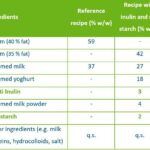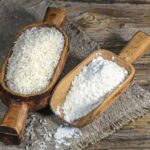Nowadays, as health awareness is growing, consumers are paying more and more attention to ingredient lists, with the nutritional value table and nutri-score gaining in importance. And despite the current hype around protein, interest in the fat content of a product remains strong: According to the latest figures from Mintel Insights, more than one in five Germans looks for low fat content when buying food. There is scope for fat reduction in many categories, particularly dairy products and their plant-based alternatives, as well as sausages, sweets and bakery products.
Consumers are looking for products that contain fewer calories but they don’t want to compromise on taste and texture. However, effectively combining the two is no mean feat for manufacturers. That’s because when fat is reduced in a recipe, it also means the loss of an essential flavor carrier and texturiser. A fat substitute or replacement must therefore meet high sensory and technological requirements. Another aspect is that consumers are particularly interested in substances of plant origin that allow for a „lean“ and comprehensible list of ingredients. Ideally, they should also be compatible with product claims such as „organic“ and „non-GMO“. With inulin from the chicory root and rice starches, Beneo offers two plant-based solutions for fat replacement that complement each other in formulations.
Inulin: Fat out, fibre in
Beneo extracts inulin from the root of the chicory plant using a gentle hot water extraction process. Orafti Inulin owes its suitability as a fat substitute to its long-chain molecular structure and low solubility. These properties enable the ingredient to form a structure similar to that of fat in aqueous systems under high shear. Inulin is highly suited for use in foods such as desserts, cream cheese preparations, processed cheese, yoghurt, sauces and sausages.
At only 2 kcal/g, the dietary fibre provides significantly less energy than fat at around
9 kcal/g, thus enabling reduced calorie content in the end product.
However, food manufacturers are not only paying increasing attention to inulin because it can replace fat but also because, as a prebiotic fibre, it brings a range of health benefits and enhances the nutritional profile of end products. Fortification is valuable given the worrying lack of fibre intake in the population as a whole – the German Nutrition Society recommends a minimum of 30 g per day, but most people regularly fall short of this. Here, products containing inulin offer a practical solution. Depending on the amount added, the end product can also be claimed as a source of fibre or one with increased fibre content.
With its prebiotic properties, inulin has a positive effect on the intestinal flora, i.e. the totality of all microorganisms that colonise our gut: Studies such as the recently published systematic review by Nagy et al. demonstrate that the consumption of chicory root fibre increases the number of gut-friendly Bifidobacteria and thus leads to improved bowel function parameters. Consumers are increasingly interested in such additional benefits as they come to better understand the vital role the gut plays in physical well-being. Their desire for improved intestinal health also influences consumer behaviour, as demonstrated by yoghurt, for example: According to their own statements, 57 % of Germans who typically consume yoghurt or yoghurt drinks turn to these products to support their digestive health. If manufacturers enrich these foods with additional dietary fibres, their digestive benefits increase.
Rice starch for mouthfeel and structure
With rice starch, Beneo offers another ingredient which can be used as a fat substitute and is becoming increasingly popular. Only last year, the company expanded its production capacity in Wijgmaal, Belgium, by 50 % to meet growing demand. Rice starch has a neutral taste and is hypoallergenic. It is also popular because it can be used to create particularly creamy textures: At 2 to 8 μm, it has the smallest granule size of all starches and is within a similar size range to fat globules. This allows rice starch to mimic the mouthfeel of fat. The molecular structure of rice starch also allows for the creation of soft gels that are highly creamy.
Depending on the type of rice starch, different textures can be achieved: Short textures are ideal for replacing fat in puddings or mousses, while the the long ones are best for yoghurts or creamy desserts. In water-based systems, such as dairy products, the starch granules swell when exposed to heat and bind the liquid in the recipe. This is how the starch provides body and stability. At the same time, the small particles help maintain the desired creaminess.
Both inulin and rice starch are natural, non-GMO and suitable for clean label recipes. In addition to the conventional version, they are available as organic ingredients that meet particularly high quality and transparency requirements.
Concepts with vision
With inulin and rice starch, food manufacturers looking for solutions in fat reduction will not only find the right ingredients at Beneo, but also holistic support. Together with their customers, the company looks at the purpose that fat is currently serving in the product and at the desired goal of the reformulation to assess which ingredient composition would work best. Beneo also keeps an eye on other criteria that the end product should fulfil – be it a comprehensible list of ingredients or specific health or nutrition claims.
The result of a successful cooperation with a client is, for example, a recipe for fat-reduced dairy spread. In this sample recipe, both inulin and rice starch are used. Rice starch binds water and gives the dairy spread more body and a soft texture. At the same time, Orafti Inulin underlines the creaminess of the product and supports spreadability. The product is considered both fat-reduced and a source of fibre.
Beneo GmbH, Mannheim











